Newsletter
Current
Previous
|
December 2022
|
|
|
|
|
At the time of writing, COP 27 is under way, opening with stark warnings of the accelerating pace of climate change and increasingly extreme weather graphically illustrated by the recent flooding in Pakistan and Nigeria, sizzling summer temperatures in Europe and drought in East Africa. Of course, we experienced uncharacteristically hot weather ourselves this summer, with a hosepipe ban and Maiden Erlegh Lake falling to exceptionally low levels (see photo below). And this, we are told, this is just a foretaste of what is to come. Speaker after speaker addressed the conference, vying to present the grimmest of warnings. One of our local MPs was among them. Alok Sharma, president of last year’s COP 26, gave a ceremonial speech in which he claimed “some progress in implementing the commitment we delivered in Glasgow” – the Glasgow Climate Pact, which “closed the Paris Rulebook” and “kept 1.5 degrees alive” – not least that “over 90% of the global economy is now covered by a net zero target, up from less than 30% when the UK took on the COP26 role.” He accepted that “leaders around the world have faced competing priorities this year”, but added that, “as challenging as our current moment is, inaction is myopic, and can only defer climate catastrophe”. So, let us all, individually and collectively, act where we can.
|
|
 Low water on Maiden Erlegh Lake
Low water on Maiden Erlegh Lake
|

Photo: Edwin Trout
Autumn: Season of Mists and Fruitfulness
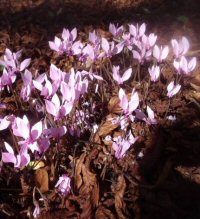 Not perhaps a vintage year for fungi, but there have been numerous examples in our local verges and woodland none-the-less, such as the magnificent specimen above, photographed on the Whiteknights campus. But the dainty cyclamen have been out in force this autumn, as illustrated by these examples among the leaf litter in The Wilderness. Not perhaps a vintage year for fungi, but there have been numerous examples in our local verges and woodland none-the-less, such as the magnificent specimen above, photographed on the Whiteknights campus. But the dainty cyclamen have been out in force this autumn, as illustrated by these examples among the leaf litter in The Wilderness.
|
|
Committee News
Announcements from the latest committee meeting.
The Committee
The Earley Environmental Group is run by a committee of local residents, all of whom volunteer their time and talents to ensure a well run and active group. However, since the ‘reshuffle’ at the AGM we have been short of a Secretary, so if you feel able to take minutes and handle any correspondence, please do get in touch via the website, or contact Bob Collis.
Newsletter: printed copies?
Since the newsletter was introduced, Oracle Corporation has kindly printed copies free of charge to enable the Group to distribute them to those without email and provide introductory material to visitors at our events. However, this issue is the last to be printed under this arrangement, though Oracle Corporation does wish to continue its support of the Group. Their representative Ian Murty says: “I applaud the work that your group has been doing through the years and it would be brilliant to maintain a relationship with you moving forward.”
|
Congratulations
 Bob Collis (right) at the Green Fair, congratulated by a member of the public on his close-up of the White-letter Hairstreak, as featured on the cover last time and which illustrates Alan Broodbank’s article. Bob Collis (right) at the Green Fair, congratulated by a member of the public on his close-up of the White-letter Hairstreak, as featured on the cover last time and which illustrates Alan Broodbank’s article.
EASI
Earley Adopt-a-Street Initiative (EASI) is looking for volunteers to help keep Earley free of litter by taking on their local streets to pick litter on a regular basis. EASI currently has 312 volunteers who are picking most of our streets in Earley, but new members are required. Litter- picking equipment is supplied. If you are interested, please email the organiser.
Community Orchard AGM
The orchard group’s AGM took place on 30th October, with reports on progress from the committee, a walk around the orchard and afternoon tea with Berkshire apple cake, apple streusel tart, and French apple bateaux among other apple-related delicacies.
|
|
|
|
Planning Matters
A round-up of developments that affect the land use and planning status of space in our area.
EEG’s Proposed Green Corridor Network Progresses
Making Space for Nature
The EEG’s proposal for the adoption of a Green Corridor Network for Earley continues to make progress. The mapping work is now in its final stages with the conceptual corridors previously identified are now developed in more detail. Four Corridors have been mapped out; a northern corridor running alongside the Thames and Kennet, a central corridor running between Bulmershe and Reading University, a Maiden Erlegh corridor (click here to see the map) and a Loddon/Lower Earley corridor. The latter would encompass the EEG’s proposed Lower Earley Local Nature Reserve. The final versions of the network would include core areas of natural and cultivated green space, linked by stepping stones and green links comprising small green spaces, local parks and green routes. Linking to areas outside Earley, such as Highwood and Dinton Pastures would form important aspects of the network. The aim of the map would be to bring together all Earley’s green spaces to form a network that can be protected and enhanced as a comprehensive body of ecological sites within which each core area, corridor and stepping-stone has a role to play in providing wildlife habitats and routes, as well as leisure areas for Earley’s residents.
Bob Collis
|
Maiden Erlegh 3G Pitch Proposal -
- EEG’s Response
Bob Collis
At the beginning of the year the EEG joined forces with the Maiden Erlegh Residents Association (MERA) and a local residents’ group (MBOS) to oppose Wokingham Borough Council’s proposal to build a 3G artificial pitch on the lower field at Laurel Park next to the Maiden Erlegh Nature Reserve. The proposal for Laurel Park has since been withdrawn. The Council has, however, now developed a proposal for a new 3G pitch to be located at Maiden Erlegh School, and held a public consultation on the proposal at the school in September. Although some of the proposed 3G pitch would cover the exiting artificial pitch, it would result in the loss of a large area of the existing grass playing field. The new pitch would be available for hire until 10pm on weekdays and until 8pm at weekends. It is expected that the pitch would be used by either the school or local football clubs on most days of the week.
The proposal to build a 3G pitch at Maiden Erlegh School on the existing green space is of great concern to the EEG. The playing field, together with nearby Buckhurst Copse, form part of a natural green corridor linking nearby green spaces, such as Sol Joel Park and Maiden Erlegh Nature Reserve. The green space is an important natural habitat and food source for mammals, bats, birds and insects that live and pass through the area. Furthermore, the Maiden Erlegh playing field contributes to the reduction of our carbon footprint, and its preservation would contribute to WBC’s targets for carbon reduction. It is the EEG’s view that this valuable green space, together with Buckhurst Copse, must be preserved from the impact of increased human activity and the effects of the increased noise, artificial light and water run-off generated by the proposed pitch. There would also be a substantial impact on some properties in Avalon and Sevenoaks Roads. In Avalon Road, in particular, the pitch fencing and lighting masts would be very close to the boundary fences of properties backing onto the playing field.
While WBC’s recent consultation for the proposal provided the public with a generalised concept for the proposal there was little detailed information to support the case for the pitch and to assess its impact. Furthermore, although WBC claim that it would be possible to mitigate some of the adverse impacts of the pitch it has not been made clear how this would be done.
The EEG would expect WBC to produce a detailed assessment of the demand for a new 3G pitch in Earley and of the suitability, or otherwise, of alternative sites. It should also produce a more detailed design for the pitch, an assessment of potential pollutants from the pitch structure, a detailed traffic impact assessment and assessments of the impact of noise and lighting on Buckhurst Copse and adjacent properties. Most importantly, WBC needs to produce comprehensive Environmental Impact and Ecological Impact Assessment Reports for the proposal.
The EEG has responded to the consultation asking for a second consultation phase to be held, before any Planning Application is submitted, at which all these documents will be made available to enable local residents and interest groups to see the detailed evidence justifying the pitch, and for them to be able to respond effectively.
|
|
Success
A celebration of recent successes.
The Make a Difference Award
Dating from March 2020, as the Covid-19 pandemic first took hold, the BBC introduced a series of awards to celebrate those who made a difference in their local communities – initially in responding to the public health crisis. These ‘Make a Difference Awards’, arranged through the local radio network, were repeated in 2021 and again, post-pandemic, in 2022.
Throughout the summer, our local station has sought nominations and broadcast inspirational interviews with those on the shortlist. Then on 3rd September, Radio Berkshire held its awards ceremony in Reading Town Hall. There were eight categories, celebrating great neighbours, inspirational fund-raisers, thoughtful volunteers and outstanding key workers. One of the accolades on offer was the Environmental Award, which this year was won by Freely Fruity, described as “based in Winnersh, supplying local grown fruit and veg for those in need”.
And by happy coincidence, the Earley Environmental Group had recently featured Freely Fruity in its programme of walks and talks, as was reported in the August issue of this newsletter. We offer our congratulations to these worthy winners.
|
Project Hairstreak – four years on
Alan Broodbank
We pick up the August issue’s headline news for a little more detail.
Four years ago (Autumn 2018) in these pages, I described the Earley Environmental Group’s project to firmly establish the White-letter Hairstreak butterfly as a breeding species on Maiden Erlegh Nature Reserve. To facilitate this, we had been given a number of Elm saplings, the butterfly’s foodplant, in return for a donation to the Butterfly Conservation charity. The donation was given by Richard Beard, himself a butterfly conservationist in Canada, in memory of his father who had played a pivotal role in saving our lake and Nature Reserve from development during the 1960’s. The article that I wrote at the time can be found on the EEG website (www.earleyenvironmentalgroup.co.uk) under the heading, “Hope for the White-letter Hairstreak in Earley.”
I can now report with a great deal of satisfaction that the Elm trees planted by the Wednesday Volunteers have not only survived but are healthy and thriving. They are now fine, well-established saplings with no sign of Dutch Elm disease (so far!). Somewhat optimistically I have occasionally examined the lower branches for White-letter Hairstreak larvae or pupae but have found none as yet, which is, I suppose, hardly surprising. A number of the leaves had been eaten but that could be down to any number of causes.
Now for the even better news! Since the project began there has been a number of “probable” sightings of the White-letter Hairstreak but no incontrovertibly definite proof. That all changed abruptly on 18th July 2022 when, for the very first time, a beautiful newly-emerged White-letter Hairstreak was photographed by EEG member Bob Collis in his garden adjacent to the Reserve. Its pristine appearance is evidence that it had clearly not travelled far and is therefore very likely to have been born and bred on the Reserve. Whether or not it had actually lived on one of our new Elm trees is obviously impossible to tell but it’s an attractive thought! But there can be no doubt about its identity.
So, it really does seem likely that the White-letter Hairstreak is establishing a foothold, albeit a precarious one, in our Nature Reserve. We are obviously keen to monitor its progress, so please do keep a sharp eye open for this pretty little butterfly and ideally photograph it. Please send any sightings to the editor Edwin Trout. In April or May, you may also like to have a go at looking for the bright green woodlouse-shaped caterpillar on the underside of Elm leaves, or even a pupa which looks like a small brown lump of mud or rolled-up dead leaf. Good luck!

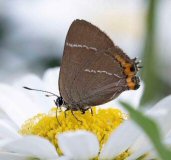
The elms sited at the eastern end of Maiden Erlegh Lake and the White-letter Hairstreak spotted this summer (photos: Bob Collis)
|
|
Recent Activities
A round-up of the Group’s practical activities.
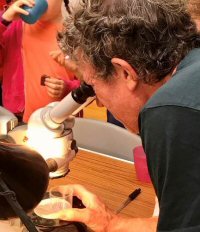
Following the success of this year’s Bug Hunt and to credit the central contribution of Alan Broodbank to the success of this annual event, the committee agreed to name it the Broodbank Bug Hunt henceforth.
Wednesday Volunteers
Every Wednesday morning the EEG group of volunteers can be found working on practical projects on the Reserve or around Earley. Why don’t you give it a go? 07796 170 689 for details.

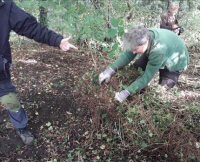
|
The Broodbank Bug Hunt 2022
Charlotte Allchin
25th July seems a long time ago now but for the attendees of this year's bug hunt, it is a very happy memory. Several families met at the Interpretation Centre for a safety briefing before heading out with nets and insect collecting pots to see what they could find.
Participants of all ages joined in with great enthusiasm and although not all 27,000 types of UK insect were found, over 25 different species were. These were carefully observed by eye and then a few were taken back to be observed under the microscope which caused much excitement and awe in those looking through the lens.
Thank you to all those who chose to spend their time in the nature reserve that afternoon and particular thanks go to Alan Broodbank and his wonderful side-kick Kirsty.

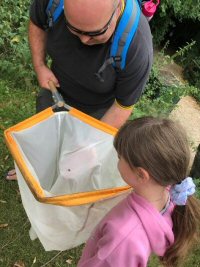
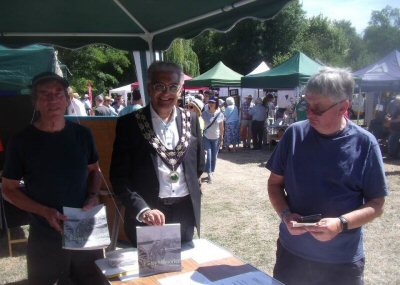 The Mayor of Earley at one end of the EEG display at August’s Green Fair.
The Mayor of Earley at one end of the EEG display at August’s Green Fair.
|
|
Recent Events
Programme organiser Charlotte Allchin recalls the Bat Walk in September.

Our youngest bat walk attendee was mesmerised by the sight and sounds of the pipistrelles above his head
Thames Valley Park Autumn Litter-Pick
On 12th October, the EEG’s Wednesday Volunteers, together with members of the Earley Adopt-a-Street Initiative (EASI), took part in Earley Town Council’s Annual Autumn Litter-Pick at Thames Valley Park. The litter-pick covered the Thames Path between the Waterside Centre and the Horseshoe Bridge at the mouth of the River Kennet. Many bags of litter were collected, including litter from the Thames itself, thereby helping to keep part of one of the area’s most attractive walking and cycling routes free of litter. Litter-picking equipment (pickers and bag hoops) purchased with funds kindly donated by Earley Charity and Earley Town Council, was used by our pickers. We are grateful to the Waterside Centre for their help with organising the litter pick.
|
Bat Walk 2022
Charlotte Allchin
If you had visited Maiden Erlegh Nature Reserve at dusk on Friday 2nd September, you would have seen a group of excited people collecting together as the sky began to darken. It was time for the Earley Environmental Group bat talk and walk! Adults and children gathered around and listened keenly to Rose-Ann from Berkshire and South Buckinghamshire Bat Group as she introduced many fascinating aspects of bat life that were new to the group.
Heterodyne bat detectors were given out and the group was shown how to use them to differentiate between the different bats in the reserve. Starting in the woodland and ending up alongside the lake, the group was in for a real treat as the bats were out in number and busily feeding overhead.
Common and soprano pipistrelles flitted through the trees and over the heads of the group as they watched them silhouetted against the sky. Daubenton bats skimmed millimetres from the surface of the lake and their light furry stomachs caught the last of the evening light.
The group was delighted with what they had seen and several commented that they had walked the lake path of an evening oblivious to the incredible little creatures flying all around them. Rose-Ann reminded the group of the difference that keeping our pet cats in at the hours around dusk and dawn can have on keeping the number of 'catted' bats down and what to do if one finds a bat that needs help (call the Bat Conservation Trust 0345 1300228).
As the evening ended, rain started to fall and we imagined the bats would be heading home after their frenetic feeding session. We did the same! Thank you to Rose-Ann for her time and expertise, and thank you to all who made the time to come out and take part.
Autumn Litter-Pick cont.
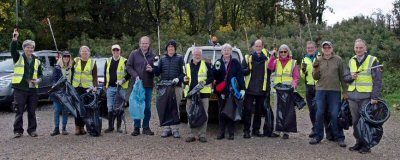
Volunteers out in force for the October litter pick
Text (left) and photo: Bob Collis
|
|
Maiden Erlegh LNR
What’s happening on Maiden Erlegh Lake and nature reserve
Nature Notes
What happened to the swan?
As most will be aware, the old swan died in early December last year, only for his place on Maiden Erlegh Lake to be taken by a pair of new swans in late February. These two have become a fixture since, but then for a few days in late August there was only one. A ‘SwanSupport’ van was seen in the vicinity, and within a few days there were two again. Does anyone know what happened?
Late / early Egyptian goslings
The pair of Egyptian geese, long-term habitués of Maiden Erlegh Lake, produces a clutch most years, with youngsters appearing in February and March – noticeably earlier than other ducks and geese – though in 2020 it was not until May. They are usually the first hatchlings on Maiden Erlegh Lake, and can vary in number from eight (2009) to just one (2020). This year there were eight, down to five goslings in early February, and after dispersing in June, the adults returned in the autumn. Remarkably, they produced a second brood, first seen on 11 October, but all five had disappeared within the week.
Shovelers: early arrival
The shy and rather flighty shoveler visits Maiden Erlegh Lake in some number during the autumn, perhaps reaching as many as 40 or more over the winter of 2017-18. Smaller numbers of 7-14 are more typical, however. They arrive in November and depart shortly before breeding in April, but this year they were early: first seen on 1 October.
|
American Mink in Berkshire
Edwin Trout
The widespread, but elusive mink is an occasional sighting in Berkshire – there was one around Maiden Erlegh Lake apparently, about 20 years ago – but latterly it has been seen repeatedly on the banks of the River Blackwater by Sandhurst’s Shepherd Meadows.
The American mink is native to North America, at least north of the southwestern arid zone up to and including Alaska, though south of the high Arctic. Mink are to be found in areas of high water quality. They are small-bodied – at 15-18” the males are twice the length of the females and have proportionately bigger jaws and teeth. They are foragers and opportunistic feeders with a broad diet of birds, amphibians, reptiles, rodents, insects, and crustaceans. They can hunt like foxes, climb like cats and swim like an otter; males will eat rabbits, while females eat water voles. They are semi aquatic and very adaptable. While native to North America, they were introduced into Europe and elsewhere, largely as a result of the former demand for their fur. In the 1920s and ‘30s they were farmed, but later, in the 1950s, many escaped or were released. They are now regarded as an invasive species.
An Invasive Species
There is little evidence of hybridisation or disease transmission, but increased predation and competition for resources are a problem. Direct predation by mink is most notable in the UK on water voles. Female mink are the right size to enter voles’ underwater holes and the water vole population is declining fast. This is, admittedly, for various reasons, but the presence of mink is contributory. Other vulnerable species are ground-nesting sea birds, for which the security of islands and rocky outcrops are no protection against the semi-aquatic mink, which has little sense of restraint or forward planning.
Competition for resources has also had a notable impact on the European mink, which is now limited to Estonia and the Pyrenees, as the American mink is sufficiently well-equipped to out-compete, being more voracious and adaptable. Its success can also be seen in its competition with polecats and otters. When these species were declining in the 1920s-50s, mink expanded into their vacated niches, on both land and water.
Competition with Otters
Mink behaviour has altered over time, with the evidence of scat declining since the otter’s resurgence in the 1990s. However, if other evidence such as footprints is taken into account, it appears that mink remain, but are no longer deliberately marking their territory. Otters are bigger, and may weigh 8 kg, so while the feisty mink might be prepared to fight, it wouldn’t wish to make a habit of it. So what seems to be happening is that when the nocturnal otter returns, mink behaviour adapts to the new circumstances and becomes diurnal, thus avoiding confrontation.
And thus it seems with the latest early morning sightings: a solitary individual occupies its own linear territory along the riverbank, and is active during daylight.
For more information on the American Mink, see: Bagniewska, J.
‘Mink – Evil or Interesting?’ Reading: Berkshire Mammal Group, 2016
|
|
EEG Programme
We list the Group’s forthcoming walks and talks – fuller details are on the EEG website.
2022 Programme
Walks and Talks
Please see the EEG website and public notice boards for further details and updates.
16th November
Dr George McGavin at 19.15
17th December
Lantern-making at 15.00, and
Carols around the lake at 16.00. If particularly wet, this may be postponed to 18th Dec.
Dr George McGavin
The talk by Dr George McGavin, whom you may recognise from your television screens, is on ‘All Creatures Great and Small’. It will be all about insects and their enormous importance for our existence on this planet.
Dr McGavin is a British entomologist, author, academic, television presenter and explorer and his talk promises to be full of his own experiences and stories. This talk will suit an audience of most ages but is probably best suited to teens and adults.
BOOKING IS ESSENTIAL.
Contributors to this issue
Charlotte Allchin
Alan Broodbank
Bob Collis
Patricia Green
John Medcraft
Edwin Trout
Elizabeth Trout
|
2023 Programme: Walks and Talks
Jan - AGM and Members Slides
Feb - ‘Re-wilding Earley: Earley’s Green Corridors’, talk by Bob Collis
Mar - HELP Spring Litter Pick
April - Walk 1 from walks and cycle rides book.
May - Dawn Chorus walk
June - Walk 2 from walks and cycle rides book.
July - Broodbank Bug Hunt
Aug - Green Fair.
Sept - Bat walk
Oct - Autumn Litter Pick
Nov - Walk 3 from walks and cycle rides book.
Garden Surveys
Some notable entries from members’ records
I have seen both the garden tiger moth and the Jersey tiger moth in my garden. Last year the garden tiger moth was also around, and I saw one also by St Michael's Churchyard.
Patricia Green
During early summer this year we were sitting on the seats at the Beech Lane end of the lake when we had two sightings of a kingfisher alighting on the willow tree just in front of us. This was the first time we had been aware that kingfishers were in the area.
John Medcraft
Kingfishers
 Seen only occasionally, the Kingfisher seems to arrive at the lake from the direction of the River Loddon, travelling along the line of the stream through Moor Copse and Old Pond Copse. They tend to be seen singly, though pairs do visit. They are often given away by their low straight flight over the water, their characteristically brilliant colours only noticeable once they have passed by, and are difficult to spot when still. If you do see them, try to follow their movement from perch to perch, as they usual travel in short stages between branches. They are charismatic birds, with the excitement of a sighting enhanced by its rarity. If you are lucky, you might see them up to half a dozen times a year (and 2021 was a bumper year), though once or twice is more usual – but they’ll always catch you by surprise. Seen only occasionally, the Kingfisher seems to arrive at the lake from the direction of the River Loddon, travelling along the line of the stream through Moor Copse and Old Pond Copse. They tend to be seen singly, though pairs do visit. They are often given away by their low straight flight over the water, their characteristically brilliant colours only noticeable once they have passed by, and are difficult to spot when still. If you do see them, try to follow their movement from perch to perch, as they usual travel in short stages between branches. They are charismatic birds, with the excitement of a sighting enhanced by its rarity. If you are lucky, you might see them up to half a dozen times a year (and 2021 was a bumper year), though once or twice is more usual – but they’ll always catch you by surprise.
(Ed: My sightings in 2022 were on 22 January, 11 February and 19 July – all at the western end of the lake.)
Photo: Andrew McKie, www.pexels.com
Thanks to ORACLE Corporation for reproducing our newsletter on recycled paper. Oracle is the world's second largest software company, situated at Thames Valley Business Park in Earley. Oracle UK adheres to the ISO14001 Environment Standard which confirms Oracle has considered and acted upon its environmental impact. As part of Oracle’s corporate social responsibility they support a number of local groups, including us. They have given us valuable support in reproducing the hard copies of our newsletter in colour, as well as printing posters and membership leaflets for us to distribute to libraries, schools etc.
|
|
|